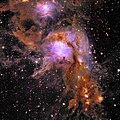Messier 78
| Reflection nebula | |
|---|---|
 Image of Messier 78 captured using the Wide Field Imager camera on the MPG/ESO 2.2-metre telescope at the La Silla Observatory. | |
| Observation data: J2000.0 epoch | |
| Right ascension | 05h 46m 46.7s[1] |
| Declination | +00° 00′ 50″[1] |
| Distance | 1,350 ly (415 pc)[2] ly |
| Apparent magnitude (V) | 8.3[3] |
| Apparent dimensions (V) | 8′ × 6′[3] |
| Constellation | Orion |
| Physical characteristics | |
| Radius | 5 ly |
| Notable features | Part of the Orion complex |
| Designations | Ced 55u, DG 80, IRAS 05442-0000, [KPS2012] MWSC 0664, NGC 2068[1] |
Messier 78 or M78, also known as NGC 2068, is a reflection nebula in the constellation Orion. It was discovered by Pierre Méchain in 1780 and included by Charles Messier in his catalog of comet-like objects that same year.[4]
M78 is the brightest diffuse reflection nebula of a group of nebulae that includes NGC 2064, NGC 2067 and NGC 2071. This group belongs to the Orion B molecular cloud complex and is about 1,350 light-years distant from Earth.[2] M78 is easily found in small telescopes as a hazy patch and involves two stars of 10th and 11th magnitude. These two B-type stars, HD 38563 A and HD 38563 B, are responsible for making the cloud of dust in M78 visible by reflecting their light.[5]
The M78 cloud contains a cluster of stars that is visible in the infrared.[2] Due to gravity, the molecular gas in the nebula has fragmented into a hierarchy of clumps,[2] whose cores have masses ranging from 0.3 M☉ to 5 M☉.[6] About 45 variable stars of the T Tauri type,[7] young stars still in the process of formation, are members as well. Similarly, 17 Herbig–Haro objects are known in M78.[8]
On May 23, 2024, the European Space Agency released an initial set of images from their Euclid mission. This included an unprecedented image of the region including M78.[9] It showed hundreds of thousands of new objects including sub-stellar sized ones for the first time.
Gallery
[edit]-
VISTA image of Messier 78.
-
Spitzer image of Messier 78.
-
Euclid image of star-forming region Messier 78
See also
[edit]References
[edit]- ^ a b c "M 78". SIMBAD. Centre de données astronomiques de Strasbourg. Retrieved 14 February 2016.
- ^ a b c d Walker-Smith, S. L.; Richer, J. S.; Buckle, J. V.; Smith, R. J.; Greaves, J. S.; Bonnell, I. A. (March 2013), "The structure and kinematics of dense gas in NGC 2068", Monthly Notices of the Royal Astronomical Society, 429 (4): 3252–3265, arXiv:1212.2018, Bibcode:2013MNRAS.429.3252W, doi:10.1093/mnras/sts582.
- ^ a b "Messier 78". SEDS Messier Catalog. Retrieved 30 April 2022.
- ^ Frommert, Hartmut; Kronberg, Christine (9 October 2018), "Messier 78", SEDS Messier pages, Students for the Exploration and Development of Space (SEDS), retrieved 5 December 2018.
- ^ Strom, S. E.; et al. (July 1974), "Infrared and optical observations of Herbig-Haro objects.", The Astrophysical Journal, 191: 111–142, Bibcode:1974ApJ...191..111S, doi:10.1086/152948.
- ^ Motte, F.; et al. (June 2001), "A SCUBA survey of the NGC 2068/2071 protoclusters", Astronomy and Astrophysics, 372 (3): L41–L44, arXiv:astro-ph/0105019, Bibcode:2001A&A...372L..41M, doi:10.1051/0004-6361:20010543, S2CID 7658059.
- ^ Herbig, G. H.; Kuhi, L. V. (February 1963), "Emission-Line Stars in the Region of NGC 2068", The Astrophysical Journal, 137: 398, Bibcode:1963ApJ...137..398H, doi:10.1086/147519.
- ^ Zhao, Bing; et al. (September 1999), "Newly Discovered Herbig-Haro Objects in the NGC 2068 and NGC 2071 Regions", The Astronomical Journal, 118 (3): 1347–1353, Bibcode:1999AJ....118.1347Z, doi:10.1086/301002.
- ^ "Euclid's new image of star-forming region Messier 78". The European Space Agency. ESA/Euclid/Euclid Consortium/NASA. 23 May 2024. Retrieved 27 May 2024.
External links
[edit]- Messier 78 on WikiSky: DSS2, SDSS, GALEX, IRAS, Hydrogen α, X-Ray, Astrophoto, Sky Map, Articles and images
- SEDS: Starforming Nebula M78
- NASA Astronomy Picture of the Day: M78: Stardust and Starlight (4 November 2005)
- NightSkyInfo.com – M78
- Astronomy Picture of the Day
- M78 Wide Field 2009 November 26
- M78 and Reflecting Dust Clouds in Orion 2010 March 2
- Haran, Brady; Haese, Paul. "M78 – Reflection Nebula". Deep Sky Videos. Nottingham Astronomy Group, University of Nottingham.
| List |
| |
|---|---|---|
| See also | ||
Text is available under the CC BY-SA 4.0 license; additional terms may apply.
Images, videos and audio are available under their respective licenses.




